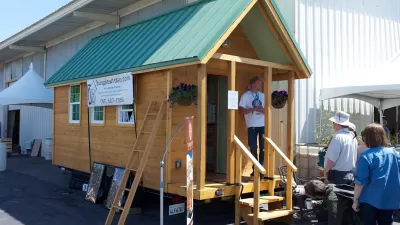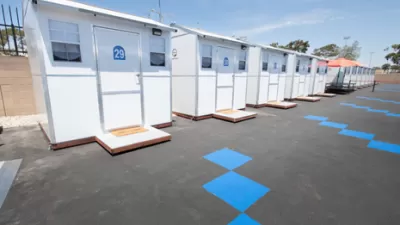While cities like New York and San Francisco consider ways to incentivize the development of micro apartments, a Northeast Washington neighborhood has become home to an experiment in small house production.

In an extreme reversal of America's pre-recession housing tastes, the McMansion seems to be going out of favor while the country's appetite for exceedingly small living spaces in urban areas seems to be growing. The latest incarnation of this trend can be found in the Northeast Washington D.C. neighborhood known as Stronghold, where "a cluster of what neighbors call 'those tiny people, building their tiny houses,' has appeared, reports Emily Wax. "The people aren’t really tiny, but their homes are — 150 to 200 square feet of living space, some with gabled roofs, others with bright cedar walls, compact bathrooms and cozy sleeping lofts that add up to living spaces that are smaller than the walk-in closets in a suburban McMansion."
"The group behind Stronghold’s tiny-house community calls itself Boneyard Studios," writes Wax. “'As property values and rents rise across the city, we want to showcase this potential option for affordable housing,' the group writes on its Web site. 'We decided to live the questions: Can we build and showcase a few tiny homes on wheels in a DC urban alley lot? . . . Not in the woods, but in a true community, connected to a neighborhood? Yes, we think. Watch out left coast, the DC adventure begins.'”
"There’s one problem: The city’s zoning laws don’t allow residential dwellings on alley lots unless they are a minimum of 30 feet wide, or roughly the width of a city street. D.C. is currently discussing lifting the 30-foot restriction. So, as Boneyard Studios continues to advocate more progressive zoning laws, it is using the property to showcase what could be."
FULL STORY: Home, squeezed home: Living in a 200-square-foot space

Alabama: Trump Terminates Settlements for Black Communities Harmed By Raw Sewage
Trump deemed the landmark civil rights agreement “illegal DEI and environmental justice policy.”

Planetizen Federal Action Tracker
A weekly monitor of how Trump’s orders and actions are impacting planners and planning in America.

The 120 Year Old Tiny Home Villages That Sheltered San Francisco’s Earthquake Refugees
More than a century ago, San Francisco mobilized to house thousands of residents displaced by the 1906 earthquake. Could their strategy offer a model for the present?

Rural Population Grew Again in 2024
Americans continued to move to smaller towns and cities, resulting in a fourth straight year of growth in rural areas.

Safe Streets Grants: What to Know
This year’s round of Safe Streets for All grant criteria come with some changes.

Rural Missouri Transit Service Could Lose State Funding
OATS Transit offers low-cost rides to primarily elderly rural residents with little or no access to other transportation options.
Urban Design for Planners 1: Software Tools
This six-course series explores essential urban design concepts using open source software and equips planners with the tools they need to participate fully in the urban design process.
Planning for Universal Design
Learn the tools for implementing Universal Design in planning regulations.
Clanton & Associates, Inc.
Jessamine County Fiscal Court
Institute for Housing and Urban Development Studies (IHS)
City of Grandview
Harvard GSD Executive Education
Toledo-Lucas County Plan Commissions
Salt Lake City
NYU Wagner Graduate School of Public Service




























